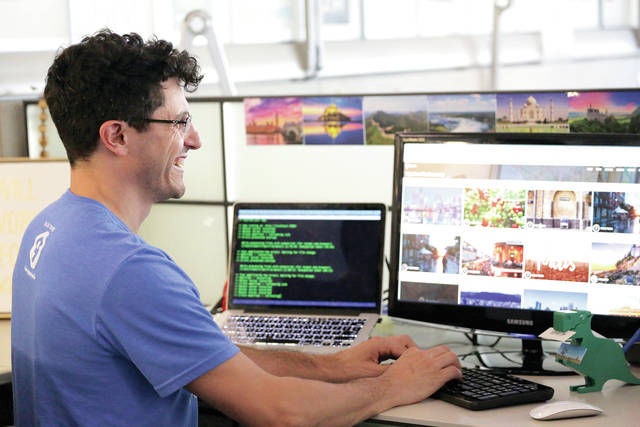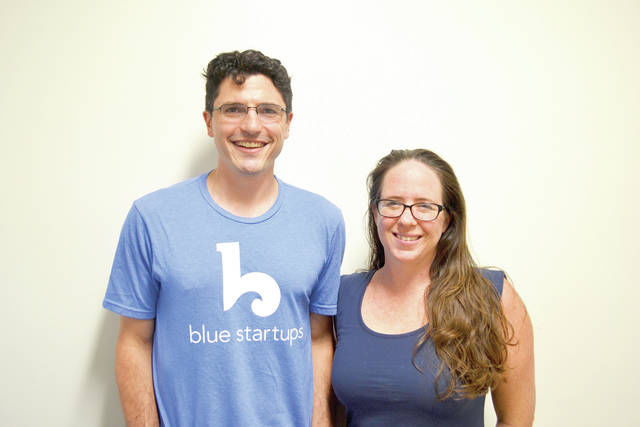Talk Story with Michelle Rundbaken and Yacine Merzouk
Not every day does a business from Kauai get accepted into a company that invests in startups and offers mentorship programs from some of the top business people in the world.
In fact, only one Kauai startup is part of the Blue Startups program, and they’re taking full advantage.
The husband and wife duo of Yacine Merzouk and Michelle Rundbaken of Wailua are taking travel planning to a new level with Tripidee, an all-in-one website and app to research locations for your trip, organize each day and crowd source information from travelers to streamline your holiday.
Tripidee is the first startup from Kauai to be accepted into the investment and mentorship-driven program that targets companies in the technology sector.
Merzouk and Rundbaken are among seven startups accepted into the ninth cohort program. There were over 200 applications. About halfway through the 14-week program, Merzouk and Rundbaken will pitch their startup to investors in San Francisco.
Why was this started?
Michelle Rundbaken: We created this because we’re from Kauai. I was teaching and you get one to two vacations a year. It’s big. You get to get off of Kauai. We found that we were gathering ideas of what to do, but it was everywhere: It was on Pinterest, Google, it was on our email from friends and we were wasting so much time on the trip trying to organize. We realized that there was no tool out there to help put all those ideas into one place on a map. If you’re going to a location you’ve never been, you can really visualize it and make the most out of your vacation time.
What was it like in the beginning?
Yacine Merzouk: In December 2015, it was for a California road trip. We literally put up a website that no one knew about and we made a mobile map that no one knew about and we used it for ourselves.
Where in California did you go?
YM: That was one central coast. We hit all the vineyards.
MR: We went from San Francisco all the way to Los Angeles. We were putting in things we wanted to do all along the way and figuring out the best route, seeing everything on a map.
Was the first iteration of what you created similar to what you have today?
MR: Similar and different, and it’s going to change a lot still. We’ve been taking it really slow. It has a lot of features now.
YM: The core of it is the same: Easily gather all of your information about a trip and because you don’t know necessarily much about the place you’re going to, it has to grab the location and put it on a map and make it easy visually to know where you’re going. That’s the same: gathering and seeing where you are and where you’re going. We added a lot of features to that to make it easier to get started, get better directions once you’re on the road, get business hours and things like that.
MR: We had a sharing feature to collaborate, but we just added a feature to crowd source from friends, and it’s like magic. Even though I grew up here, I don’t know Oahu. On Facebook, I sent out an invitation to give me Oahu off the beaten track. It was so cool because all of a sudden my whole account was populated with all these ideas from my friends who visited and now they’re all a map, all ready to try out.
How much easier was it to streamline your vacation?
MR: A lot because everything’s on a map and there’s a companion app. You’re no longer on your email, on Pinterest, looking for addresses, names. It’s just all right there.
YM: Sometimes in the morning of a trip, especially if it’s a road trip, we would spend an hour trying to figure out the best route and not forgetting anything that’s on the way. Somehow it’s a few minutes.
MR: The biggest thing about this is it will not plan the trip for you. This is for people who want to gather their own ideas. We have a universal browser button, so if you’re searching for a place and you find something you really want to do, you just click the button and it puts it into your trip.
YM: You can do your research on Google, Tripadvisor or Yelp or enter things yourself. Anywhere you’re on the web, it’s one click and it saves it to your account.
MR: What makes us different is we allow you to add any address from anywhere — even GPS. If you’re a hiker, you can put in GPS and get locations.
When were you accepted into the cohort?
YM: The program started the third week of April.
What kind of training have you received?
YM: A lot. Every week we meet with multiple mentors: business people, government people from Hawaii and the Mainland and we meet with the program directors every week. Some of the mentor meetings are workshops. Some of them are one-on-one where we get to discuss whatever we want. Sometimes the experts have their expertise and they guide us through parts of the business development process. The program director every week gives us milestones of what they would like to see over the next seven days.
MR: The quality and quantity of mentors they have is amazing. We’ve seen mentors from Asia and the continental U.S., flying in just to help us out. It’s so nice that they’re so invested in the Blue Startup program and they give their time. There’s no strings attached.
How has the mentorship helped your company so far?
MR: The mentors have all succeeded in one way or another. Either they started or launched a couple startups or they worked for big companies. They help us see different sides of our business we can’t see. They ask questions we might not know the answers to that we realized, “Oh, we need to understand this better.”
What have been the best lessons so far?
YM: Ask. A lot of people are willing to help, so get in touch with people, staying in touch with people. If you need something, let them know. If somebody needs something, help them out.
MR: For me it’s just research, research, research. Do your market research. Treat running a business like science: isolate variables, do A/B testing and don’t stop. Keep fine-tuning what works and why and keep fine-tuning more.
How do you monetize your business?
MR: We’re not monetizing yet. This has changed lot since we entered it into Blue Startups. We’ve just been a year and a half in beta and slowly collecting users. When we first started, we thought we’d monetize with affiliate links — just make money off people using Tripidee, really giving them suggestions to help them on their trip. We were quickly told that is not a way to make money. That’s just little drops in a big bucket.
Now what we’re doing is moving toward creating a tool for travel agents. A lot of people think travel agents are a dying breed, but actually the millennials are coming back to it. They don’t currently have great tools to help millennials plan. Millennials need freedom. They don’t want packaged deals. They want things on their phone, on their computer. They don’t want paper.
YM: One interesting thing we found out when we were doing tests and trying to discover what our travelers wanted, we created this feature where they can ask for suggestions. They can ask their friends or they can ask to get in touch with their travel agent. Our tools are all about being in control. You can save things from everywhere, but even so, about half of the people want suggestions.
How many people have downloaded your app?
YM: We have 2,500 users on the website. The app is around 500 right now.
MR: We’re still taking it slow. Blue Startups gave us $25,000. It’s huge, but it’s not the biggest part. The mentors are bigger. They gave us all this money and we’re not pouring it into advertising. We’re using it slowly for research and development. Because you can blow that money so fast and what do you have to show? A product that may not be perfect yet.
How much longer is the cohort?
MR: It’s a month and a half more. We’re halfway through and at the end we’re going to be going to San Francisco to pitch to investors.
YM: It’s coming fast.
MR: We’ve run small businesses before, but it’s a whole different ballgame.
What are the features you’re working on?
YM: We’re developing the agent dashboard. We’re taking all the features about travel planning and adding things and getting suggestions from friends and we’re creating a dashboard for industry professionals, travel designers, custom-trip-experience designers to be able to participate in that process. They’ll be able to see what their customers are adding or saving or would like to do. And tools to communicate: live chat, instant messages. We’re hoping to turn that into a subscription service so travel professionals have a suite of tools they can use to communicate with customers.
What are you looking forward to in San Francisco?
YM: For me, I think it’s going to be interesting to get feedback from a finished, polished presentation. We take what we have. We worked on it for three months full-time and then some. We’re going to get real feedback from real investors and other companies in our industry and it’s going to be real interesting to see what opportunities come out of that.
MR: There’s still more ways to monetize. The travel agent market is relatively small. There’s about 70,000 full-time travel agents in the U.S. There’s only so much we can scale that business. We’re still exploring more ways. As we talk to investors and professionals, we’re going to get to hear more ideas. Realistically, we don’t expect to get investors right now. We still have a lot of growth, but the ideas are really important.
Do you have a goal in the next five years?
YM: Five years is probably way further than we’re looking, but in the next couple of weeks, we’d like to get a dozen or so travel professionals beta testing our service. That’s step one.
MR: Within the next six months, we want to get about 200 travel professionals on board. As far as users, we don’t have user numbers. But ideally for Tripidee, it will be one of the go-to trip planning sites. It becomes more powerful when more people are on there.
How often do you work on this startup?
MR: Now it’s every single day.
YM: Before the program, it was every three months or so we would do a mini sprint. We would free up some time and work on it for a couple weeks. Real life would get in the way. Now that we have this program, we’ve been working on it 60-70 hours a week.
MR: Per person. And we’re reaching out and doing market research. Some of the people we’re talking to are not even in America. Our lesson is you have to work really hard. You just have to keep pushing. You know when you’re from Kauai there’s a humbleness and not tooting your horn and not really asking for help sometimes. You need to get past that. That’s hard. You have to put yourself out there and just ask and keep asking. It’s a huge lesson.
Anything you would like to add?
YM: Blue Startups invests in the company, so they take 6 percent of the company. It’s not giving. The great thing about that is our goals and their goals are aligned. If we succeed, they succeed. If we don’t. They don’t. That’s a great part of the program.



